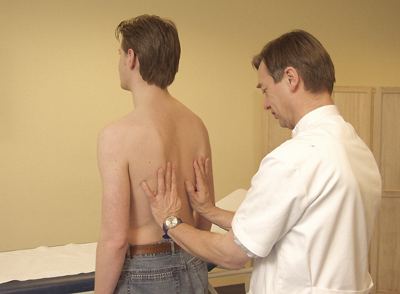Vocal fremitus means using the hands to feel the vibrations caused by the vocal sounds of the patient. During this procedure the patient is asked to speak with a low voice (usually patients are asked to say “ninety-nine”). This causes the air to vibrate. This vibration can be felt by laying one’s hands on the thorax. Differences in air density can be determined in this manner. The fact that unfortunately even healthy people have unequal left- and right-sided vocal fremitus because of the difference in volume of the left and right lung indicates that this examination is difficult to interpret. Only almost complete absence of the vocal fremitus on one side [for example due to pneumothorax, atelectasis of a lung (e.g. because of stricture of the main bronchus by a tumour) or in the presence of a large amount of pleural fluid] can be detected fairly clearly. Hence, this examination is not carried out as a matter of routine. It is only performed when percussion and/or auscultation shows any abnormalities. In such cases, the vocal fremitus of the abnormal area is compared to that on the contralateral side or, if this is not feasible, to the vocal fremitus of another, non-suspect, part of the lungs. Only in the case of clear differences should conclusions be drawn from the findings.
Procedure
- place a palm of the hand on the thoracic wall where the pulmonary abnormality is suspected.
- place the other hand onto the discounted contralateral side (or, if this is not possible, on another non-suspect location on the thoracic wall)
- ask the patient to hum or say ‘ninety-nine’ in a low voice
- determine whether there is a significant difference in the vibrations felt and if so, whether the vibrations at the suspect location have increased or decreased [Figure 22]
 Figure 22: Palpation of the vocal fremitus at the suspect area compared to the contra-lateral side while the patient says “ninety-nine”
Figure 22: Palpation of the vocal fremitus at the suspect area compared to the contra-lateral side while the patient says “ninety-nine”




























